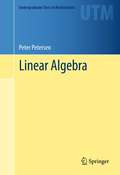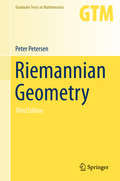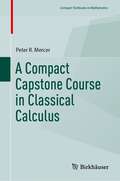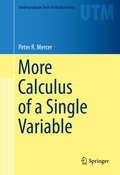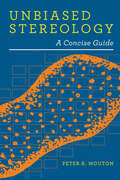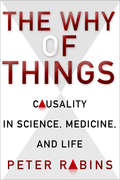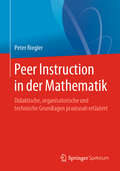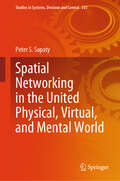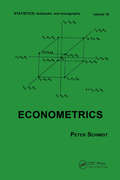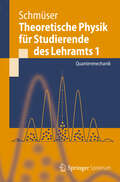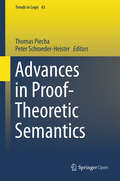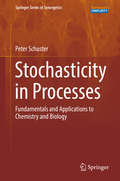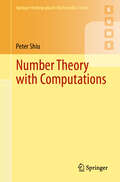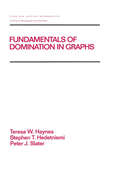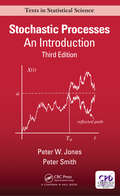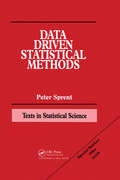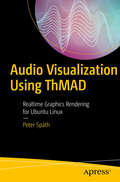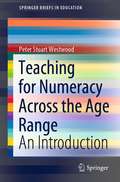- Table View
- List View
Linear Algebra
by Peter PetersenThis textbook on linear algebra includes the key topics of the subject that most advanced undergraduates need to learn before entering graduate school. All the usual topics, such as complex vector spaces, complex inner products, the Spectral theorem for normal operators, dual spaces, the minimal polynomial, the Jordan canonical form, and the rational canonical form, are covered, along with a chapter on determinants at the end of the book. In addition, there is material throughout the text on linear differential equations and how it integrates with all of the important concepts in linear algebra. This book has several distinguishing features that set it apart from other linear algebra texts. For example: Gaussian elimination is used as the key tool in getting at eigenvalues; it takes an essentially determinant-free approach to linear algebra; and systems of linear differential equations are used as frequent motivation for the reader. Another motivating aspect of the book is the excellent and engaging exercises that abound in this text. This textbook is written for an upper-division undergraduate course on Linear Algebra. The prerequisites for this book are a familiarity with basic matrix algebra and elementary calculus, although any student who is willing to think abstractly should not have too much difficulty in understanding this text.
Riemannian Geometry
by Peter PetersenIntended for a one year course, this text serves as a single source, introducing readers to the important techniques and theorems, while also containing enough background on advanced topics to appeal to those students wishing to specialize in Riemannian geometry. This is one of the few Works to combine both the geometric parts of Riemannian geometry and the analytic aspects of the theory. The book will appeal to a readership that have a basic knowledge of standard manifold theory, including tensors, forms, and Lie groups. Important revisions to the third edition include: a substantial addition of unique and enriching exercises scattered throughout the text; inclusion of an increased number of coordinate calculations of connection and curvature; addition of general formulas for curvature on Lie Groups and submersions; integration of variational calculus into the text allowing for an early treatment of the Sphere theorem using a proof by Berger; incorporation of several recent results about manifolds with positive curvature; presentation of a new simplifying approach to the Bochner technique for tensors with application to bound topological quantities with general lower curvature bounds. From reviews of the first edition: "The book can be highly recommended to all mathematicians who want to get a more profound idea about the most interesting achievements in Riemannian geometry. It is one of the few comprehensive sources of this type. " ―Bernd Wegner, ZbMATH
Stereographic Projection Techniques for Geologists and Civil Engineers
by Richard J. Lisle Peter R. LeyshonThe stereographic projection is an essential tool in the fields of structural geology and geotechnics, which allows three-dimensional orientation data to be represented and manipulated. This book has been designed to make the subject as accessible as possible. It gives a straightforward and simple introduction to the subject and, by means of examples, illustrations and exercises, encourages the student to visualise the problems in three dimensions. Students of all levels will be able to work through the book and come away with a clear understanding of how to apply these vital techniques. This revised edition contains additional material on geotechnical applications, improved illustrations and links to useful web resources and software programs. It will provide students of geology, rock mechanics, geotechnical and civil engineering with an indispensable guide to the analysis and interpretation of field orientation data.
A Compact Capstone Course in Classical Calculus (Compact Textbooks in Mathematics)
by Peter R. MercerThis textbook offers undergraduates a self-contained introduction to advanced topics not covered in a standard calculus sequence. The author’s enthusiastic and engaging style makes this material, which typically requires a substantial amount of study, accessible to students with minimal prerequisites. Readers will gain a broad knowledge of the area, with approaches based on those found in recent literature, as well as historical remarks that deepen the exposition. Specific topics covered include the binomial theorem, the harmonic series, Euler's constant, geometric probability, and much more. Over the fifteen chapters, readers will discover the elegance of calculus and the pivotal role it plays within mathematics. A Compact Capstone Course in Classical Calculus is ideal for exploring interesting topics in mathematics beyond the standard calculus sequence, particularly for undergraduates who may not be taking more advanced math courses. It would also serve as a useful supplement for a calculus course and a valuable resource for self-study. Readers are expected to have completed two one-semester college calculus courses.
More Calculus of a Single Variable
by Peter R. MercerThis book goes beyond the basics of a first course in calculus to reveal the power and richness of the subject. Standard topics from calculus -- such as the real numbers, differentiation and integration, mean value theorems, the exponential function -- are reviewed and elucidated before digging into a deeper exploration of theory and applications, such as the AGM inequality, convexity, the art of integration, and explicit formulas for π. Further topics and examples are introduced through a plethora of exercises that both challenge and delight the reader. While the reader is thereby exposed to the many threads of calculus, the coherence of the subject is preserved throughout by an emphasis on patterns of development, of proof and argumentation, and of generalization. More Calculus of a Single Variable is suitable as a text for a course in advanced calculus, as a supplementary text for courses in analysis, and for self-study by students, instructors, and, indeed, all connoisseurs of ingenious calculations.
Unbiased Stereology: A Concise Guide
by Peter R. MoutonThis update to Peter R. Mouton’s pioneering work provides bioscientists with the concepts needed in order to apply the principles and practices of unbiased stereology to research involving biological tissues.Mouton starts with a brief explanation of the history and theory of the process before defining the terms, concepts, and tools of unbiased stereological procedures. He compares and contrasts the procedures with less-exacting approaches to quantitative analysis of biological structure using specific examples from biomedical literature. The book incorporates existing best practices with new methodologies, such as the Rare Event Protocol, while simplifying the dense, often difficult literature on the subject to show the utility and importance of unbiased stereology. This clear, insightful guide goes a step further than other books on this subject by demonstrating not only how to use unbiased stereology but also how to interpret and present the results.Written by the official U.S. representative to the International Society for Stereology, this is the most complete, up-to-date resource on the science of unbiased stereology. Those new to bioscience research as well as experienced practitioners will find that Mouton’s explanations are the perfect companion for stereology courses and workshops.
The Why of Things: Causality in Science, Medicine, and Life
by Peter RabinsWhy was there a meltdown at the Fukushima power plant? Why do some people get cancer and not others? Why is global warming happening? Why does one person get depressed in the face of life's vicissitudes while another finds resilience? Questions like these—questions of causality—form the basis of modern scientific inquiry, posing profound intellectual and methodological challenges for researchers in the physical, natural, biomedical, and social sciences. In this groundbreaking book, noted psychiatrist and author Peter Rabins offers a conceptual framework for analyzing daunting questions of causality. Navigating a lively intellectual voyage between the shoals of strict reductionism and relativism, Rabins maps a three-facet model of causality and applies it to a variety of questions in science, medicine, economics, and more. Throughout this book, Rabins situates his argument within relevant scientific contexts, such as quantum mechanics, cybernetics, chaos theory, and epigenetics. A renowned communicator of complex concepts and scientific ideas, Rabins helps readers stretch their minds beyond the realm of popular literary tipping points, blinks, and freakonomic explanations of the world.
Peer Instruction in der Mathematik: Didaktische, organisatorische und technische Grundlagen praxisnah erläutert
by Peter RieglerSie möchten Ihre Lehrveranstaltungen aktivierender und wirksamer gestalten? Sie möchten die Verständnisschwierigkeiten Ihrer Studierenden besser erkennen und verstehen? Sie möchten die studentische Beteiligung steigern, zum Nachdenken und Diskutieren anregen? Lernen Sie das Potenzial von Clickerfragen für die akademische Lehre kennen – damit es bei Ihren Studierenden klick macht! In diesem Buch werden die Grundlagen der interaktiv-dialogischen Lehrmethode praxisnah erläutert. Dabei werden auch häufige Fragen zu didaktischen, organisatorischen und technischen Aspekten beantwortet, etwa:Was ist die Grundidee von Peer Instruction?Wie wirksam ist Peer Instruction? Wie überzeuge ich meine Studierenden davon?Welche technischen Voraussetzungen gibt es?Wie stelle ich gute Clickerfragen?Was sollte ich sonst noch beachten?
The Riemann Hypothesis in Characteristic p in Historical Perspective (Lecture Notes in Mathematics #2222)
by Peter RoquetteThis book tells the story of the Riemann hypothesis for function fields (or curves) starting with Artin's 1921 thesis, covering Hasse's work in the 1930s on elliptic fields and more, and concluding with Weil's final proof in 1948. The main sources are letters which were exchanged among the protagonists during that time, found in various archives, mostly the University Library in Göttingen. The aim is to show how the ideas formed, and how the proper notions and proofs were found, providing a particularly well-documented illustration of how mathematics develops in general. The book is written for mathematicians, but it does not require any special knowledge of particular mathematical fields.
Spatial Networking in the United Physical, Virtual, and Mental World (Studies in Systems, Decision and Control #533)
by Peter S. SapatyThe current book chooses graphs and networks as primary and global research objectives after reviewing different types and areas of networking and existing works on graph and network operations. The ideas of this book originate from the WAVE approach which allowed us, more than half a century ago, to implement citywide heterogeneous computer networks and solve distributed problems on them in flexible and mobile way. The invented management paradigm evolved into Spatial Grasp Technology resulted in European patent and nine previous books oriented on concrete applications in social and defense systems, security, crises management, collective robotics, space research, and others. Many obtained results were dealing with graph and network structures and problems which were extremely important in the researched areas. It aims at development of higher-level social infrastructures effectively integrating different types of networking under the same universal approach, also application of networking in new areas like organoids and brain research. This book is oriented toward system scientists, application programmers, industry managers, university students, philosophers, psychologists, and United Nations personnel too.
The EXODUS Incident: A Scientific Novel (Science and Fiction)
by Peter SchattschneiderIn the near future, Earth is suffering from climate change, famines, and fundamentalism. A global nuclear war is imminent. Interstellar probes from the Breakthrough Starshot project initiated by J. Milner and S. Hawking have discovered a habitable planet in the stellar system Proxima Centauri, just in time for the exodus of the elites. On board the EXODUS starship, the crew starts to experience strange things. The voyage to Atlantis, the new home for mankind, enters a mysterious and disquieting territory, where conspiracy theories about what is real and what is virtual emerge. THE EXODUS INCIDENT is a novel about an interstellar journey, which connects science to virtual realities and epistemology. In the guise of a final investigative report, a scientific treatise discusses the physics and mathematics behind the story: the starship, the fusion thruster, the target planet, and the journey, addressing anomalous effects which involve relativistic speed and deep space environments.
IUTAM Laminar-Turbulent Transition: 9th IUTAM Symposium, London, UK, September 2–6, 2019 (IUTAM Bookseries #38)
by Peter Schmid Spencer Sherwin Xuesong WuThis volume comprises the carefully revised papers of the 9th IUTAM Symposium on Laminar-Turbulent Transition, held at the Imperial College, London, UK, in September 2019. The papers focus on the leading research in understanding transition to turbulence, which is a challenging topic of fluid mechanics and arises in many modern technologies as well as in nature. The proceedings are of interest for researchers in fluid mechanics and industry who have to handle these types of problems, such as in the aeronautical sector.
Econometrics: Microeconomics
by Peter Schmidt"A collection of proofs of fundamental theorems, this volume utilizes a format that is exhaustive and consistent. Every result covered in ``Econometrics''is proved as well as stated. One notation system is used throughout the volume. The topics included in the book cover such areas as estimations and testing in linear regression models under various sets of assumptions, and estimation and testing in simultaneous equations models. The latter subject is treated more extensively than in most econometrics books, and the entire volume is characterized by its rigorous level of examination. "
Theoretische Physik für Studierende des Lehramts 2
by Peter SchmüserDas zweibändige Lehrbuch vermittelt die Grundlagen der theoretischen Physik und berücksichtigt dabei besonders die Quantenmechanik, die spezielle Relativitätstheorie und die Elektrodynamik für den Unterricht an Gymnasien. Band 2 bietet eine systematische Einführung in die Elektrodynamik auf Basis der Maxwellschen Gleichungen sowie eine Einführung in die relativistische Mechanik. Der Stoff wird einfach und klar dargestellt, Abbildungen und didaktische Anmerkungen erleichtern den Zugang zur Theorie und geben Hinweise für die Vermittlung im Unterricht.
Galois Representations and (φ, Γ)-Modules
by Peter SchneiderUnderstanding Galois representations is one of the central goals of number theory. Around 1990, Fontaine devised a strategy to compare such p-adic Galois representations to seemingly much simpler objects of (semi)linear algebra, the so-called etale (phi, gamma)-modules. This book is the first to provide a detailed and self-contained introduction to this theory. The close connection between the absolute Galois groups of local number fields and local function fields in positive characteristic is established using the recent theory of perfectoid fields and the tilting correspondence. The author works in the general framework of Lubin–Tate extensions of local number fields, and provides an introduction to Lubin–Tate formal groups and to the formalism of ramified Witt vectors. This book will allow graduate students to acquire the necessary basis for solving a research problem in this area, while also offering researchers many of the basic results in one convenient location.
Advances in Proof-Theoretic Semantics (Trends in Logic #43)
by Thomas Piecha Peter Schroeder-HeisterThis volume is the first ever collection devoted to the field of proof-theoretic semantics. Contributions address topics including the systematics of introduction and elimination rules and proofs of normalization, the categorial characterization of deductions, the relation between Heyting's and Gentzen's approaches to meaning, knowability paradoxes, proof-theoretic foundations of set theory, Dummett's justification of logical laws, Kreisel's theory of constructions, paradoxical reasoning, and the defence of model theory. The field of proof-theoretic semantics has existed for almost 50 years, but the term itself was proposed by Schroeder-Heister in the 1980s. Proof-theoretic semantics explains the meaning of linguistic expressions in general and of logical constants in particular in terms of the notion of proof. This volume emerges from presentations at the Second International Conference on Proof-Theoretic Semantics in Tübingen in 2013, where contributing authors were asked to provide a self-contained description and analysis of a significant research question in this area. The contributions are representative of the field and should be of interest to logicians, philosophers, and mathematicians alike.
Stochasticity in Processes
by Peter SchusterThis book has developed over the past fifteen years from a modern course on stochastic chemical kinetics for graduate students in physics, chemistry and biology. The first part presents a systematic collection of the mathematical background material needed to understand probability, statistics, and stochastic processes as a prerequisite for the increasingly challenging practical applications in chemistry and the life sciences examined in the second part. Recent advances in the development of new techniques and in the resolution of conventional experiments at nano-scales have been tremendous: today molecular spectroscopy can provide insights into processes down to scales at which current theories at the interface of physics, chemistry and the life sciences cannot be successful without a firm grasp of randomness and its sources. Routinely measured data is now sufficiently accurate to allow the direct recording of fluctuations. As a result, the sampling of data and the modeling of relevant processes are doomed to produce artifacts in interpretation unless the observer has a solid background in the mathematics of limited reproducibility. The material covered is presented in a modular approach, allowing more advanced sections to be skipped if the reader is primarily interested in applications. At the same time, most derivations of analytical solutions for the selected examples are provided in full length to guide more advanced readers in their attempts to derive solutions on their own. The book employs uniform notation throughout, and a glossary has been added to define the most important notions discussed.
Peter 2.0: The Human Cyborg
by Peter Scott-MorganThe incredible book behind the primetime Channel 4 documentary, Peter: The Human Cyborg'A remarkable account of what it means to be human and what technology can really achieve' Sunday Telegraph'Peter's story is one of the most extraordinary you will ever hear. I urge people to read it' Stephen Fry'A remarkable story . . . you're left desperate to take nothing for granted' Radio Times __________ Peter, a brilliant scientist, is told that he will lose everything he loves. His husband. His family. His friends. His ability to travel the world. All will be gone. But Peter will not give up. He vows that this will not be the end and instead seeks a completely new beginning . . . Peter has Motor Neurone Disease, a condition universally considered by doctors to be terminal. He is told it will destroy his nerve cells and that within about two years, it will take his life too. But, face-to-face with death, he decides there is another way. Using his background in science and technology, he navigates a new path, one that will enable him not just to survive, but to thrive. This is the astonishing true story about Peter Scott-Morgan: the first person to combine his very humanity with artificial intelligence and robotics to become a full Cyborg. His discovery means that his terminal diagnosis is negotiable, something that will rewrite the future.And change the world. By embracing love, life and hope rather than fear, tragedy and despair, he will become Peter 2.0. __________'Compelling . . . Scott-Morgan is a true one-off. It is in the telling of the love story, rather than the technical details of becoming a cyborg, that this book succeeds' The Times 'What's striking is Peter's constant optimism, bravery and his ability to find radical answers to problems that have confounded Britain's brightest minds' Daily Telegraph 'A soaring love story' Financial Times 'Fascinating and extremely moving' Sun
Number Theory with Computations (Springer Undergraduate Mathematics Series)
by Peter ShiuThis introductory text is designed for undergraduate courses in number theory, covering both elementary number theory and analytic number theory. The book emphasises computational aspects, including algorithms and their implementation in Python. The book is divided into two parts. The first part, on elementary number theory, deals with concepts such as induction, divisibility, congruences, primitive roots, cryptography, and continued fractions. The second part is devoted to analytic number theory and includes chapters on Dirichlet’s theorem on primes in arithmetic progressions, the prime number theorem, smooth numbers, and the famous circle method of Hardy and Littlewood. The book contains many topics not often found in introductory textbooks, such as Aubry’s theorem, the Tonelli–Shanks algorithm, factorisation methods, continued fraction representations of e, and the irrationality of 𝜁(3). Each chapter concludes with a summary and notes, as well as numerous exercises. Assuming only basic calculus for the first part of the book, the second part assumes some knowledge of complex analysis. Familiarity with basic coding syntax will be helpful for the computational exercises.
Fundamentals of Domination in Graphs (Chapman & Hall/CRC Pure and Applied Mathematics)
by Teresa W. Haynes Stephen Hedetniemi Peter Slater"Provides the first comprehensive treatment of theoretical, algorithmic, and application aspects of domination in graphs-discussing fundamental results and major research accomplishments in an easy-to-understand style. Includes chapters on domination algorithms and NP-completeness as well as frameworks for domination."
Stochastic Processes: An Introduction, Third Edition
by Peter Smith Peter Watts JonesBased on a well-established and popular course taught by the authors over many years, Stochastic Processes: An Introduction, Third Edition, discusses the modelling and analysis of random experiments, where processes evolve over time. The text begins with a review of relevant fundamental probability. It then covers gambling problems, random walks, and Markov chains. The authors go on to discuss random processes continuous in time, including Poisson, birth and death processes, and general population models, and present an extended discussion on the analysis of associated stationary processes in queues. The book also explores reliability and other random processes, such as branching, martingales, and simple epidemics. A new chapter describing Brownian motion, where the outcomes are continuously observed over continuous time, is included. Further applications, worked examples and problems, and biographical details have been added to this edition. Much of the text has been reworked. The appendix contains key results in probability for reference. This concise, updated book makes the material accessible, highlighting simple applications and examples. A solutions manual with fully worked answers of all end-of-chapter problems, and Mathematica® and R programs illustrating many processes discussed in the book, can be downloaded from crcpress.com.
Strategies for Social Inquiry: Behind the Model
by Peter SpieglerThis ambitious book looks 'behind the model' to reveal how economists use formal models to generate insights into the economy. Drawing on recent work in the philosophy of science and economic methodology, the book presents a novel framework for understanding the logic of economic modeling. It also reveals the ways in which economic models can mislead rather than illuminate. Importantly, the book goes beyond purely negative critique, proposing a concrete program of methodological reform to better equip economists to detect potential mismatches between their models and the targets of their inquiry. Ranging across economics, philosophy, and social science methods, and drawing on a variety of examples, including the recent financial crisis, Behind the Model will be of interest to anyone who has wondered how economics works - and why it sometimes fails so spectacularly.
Data Driven Statistical Methods
by Peter SprentCalculations once prohibitively time-consuming can be completed in microseconds by modern computers. This has resulted in dramatic shifts in emphasis in applied statistics. Not only has it freed us from an obsession with the 5% and 1% significance levels imposed by conventional tables but many exact estimation procedures based on randomization tests are now as easy to carry out as approximations based on normal distribution theory. In a wider context it has facilitated the everyday use of tools such as the bootstrap and robust estimation methods as well as diagnostic tests for pinpointing or for adjusting possible aberrations or contamination that may otherwise be virtually undetectable in complex data sets. Data Driven Statistical Methods provides an insight into modern developments in statistical methodology using examples that highlight connections between these techniques as well as their relationship to other established approaches. Illustration by simple numerical examples takes priority over abstract theory. Examples and exercises are selected from many fields ranging from studies of literary style to analysis of survival data from clinical files, from psychological tests to interpretation of evidence in legal cases. Users are encouraged to apply the methods to their own or other data sets relevant to their fields of interest. The book will appeal both to lecturers giving undergraduate mainstream or service courses in statistics and to newly-practising statisticians or others concerned with data interpretation in any discipline who want to make the best use of modern statistical computer software.
Audio Visualization Using ThMAD
by Peter SpäthLearn how to use Thinking Machine Audio Dreams (ThMAD), a realtime audio visualization engine for Ubuntu Linux. This book bridges the gap between programmers and artists. Both artists and developers with an inclination towards arts will profit from this book since it is a combination of a hands-on tutorial, manual, and reference, with many illustrations that accompany the explanations and tutorials.You'll learn the basics of ThMAD's open source software suite and then start experimenting and building your own rendering pipelines to create audio visualizations. You'll see how to soundly use all ThMAD's GUI functionalities, and all modules are provided in a way that will serve both intellectual curiosity and professional needs. The examples that are used as part of the software, and the tutorials included in the book, will serve as a solid basis for your own experiments.What You'll LearnUse the ThMAD software, all GUI functionalities, and all modulesDevelop your own audio visualization projectsExplore the program operations for ThMAD Artiste and ThMAD Player, including all possible options for controlling program operations.Who This Book Is ForVisual artists with some IT background, or developers with artistic inclinations. Development experience is not required, but surely helpful.
Teaching for Numeracy Across the Age Range: An Introduction (SpringerBriefs in Education)
by Peter Stuart WestwoodThis book provides an introduction to what it means to be numerate, and how numeracy can best be developed and nurtured in children and in adults. It also presents a cohesive coverage of numeracy development from early childhood to adulthood. This book draws on international research and practice to provide a comprehensive overview on the topic. It depicts and draws connections with the National Curriculum in the United Kingdom, the Australian Curriculum, and the Common Core State Standards in the United States. This book identifies skills and concepts involved in achieving functional numeracy, and provides practical advice on effective teaching, learning and assessment. It serves as a valuable guide to educators who teach mathematics in primary and secondary schools, but who are not specifically trained in the subject.
